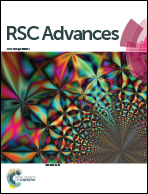Fosfomycin removal and phosphorus recovery in a schorl/H2O2 system†
Abstract
A schorl/H2O2 system was developed for fosfomycin removal and phosphorus recovery. The phosphorus removal and recovery performances and mechanisms were investigated. The results indicated that more than 90% organic phosphorus could be removed. The organic phosphorus converted into inorganic phosphorus by the Fenton-like oxidation, and about one-third inorganic phosphorus could be adsorbed on the schorl. Moreover, inorganic phosphorus greatly competed with organic phosphorus for the adsorption sites on the schorl. Oxidation and adsorption presented a synergistic effect on the phosphorus removal and recovery. Heterogeneous catalytic oxidation played an important role during the oxidation process. The kinetic results showed that the BMG model was more suitable to describe the organic phosphorus removal in comparison with the pseudo-first-order and pseudo-second-order kinetic models. The results of zeta potential, infrared spectroscopy and X-ray photoelectron spectroscopy analyses indicated that the weak electrostatic interaction between the phosphate and the attracted H+ or H3O+ on the schorl was the main adsorption mechanism. In the schorl/H2O2 system, schorl was not only the supplier for the catalyst, but also the carrier for phosphorus recovery, which proposed a new idea to degrade harmful organic pollutants and simultaneously recover useful resources.


 Please wait while we load your content...
Please wait while we load your content...